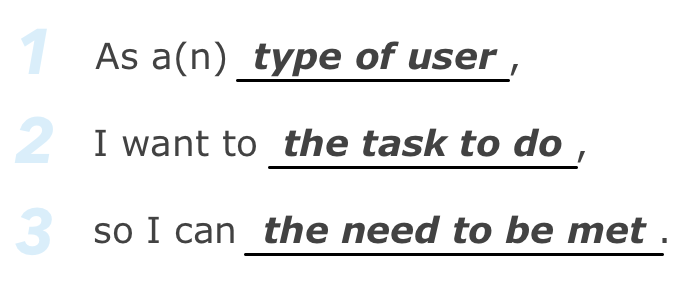User story
A user story is a content planning and development technique that helps writers focus on the scenarios and criteria of user needs, which in turn informs how to write content that fulfulls those needs. The model also helps ensure stakeholder alignment on the scenarios and criteria, as well benefits collaborative writing situations.
A user story is a content development (or revision) technique for information-as-product situations (versus information-as-persuasion). They help writers produce copy that supports the needs of users more effectively.

The process begins with a phase of audience inventigation to understand what user needs are, and how users think and talk about them. Then user stories are employed to capture each need scenario as a succinct statement. The statements inform the copy to be developed or revised.
The statement is modeled as a 3-clause sentence:1
As a(n) the type of user, I want to the task to do, so I can the need to be met.
The resulting content that follows the statements may elaborate on information to whatever extent is appropriate. But the initial audience analysis work is essential to ensure the content makes sense to those who need it, not to those who wrote it. It’s best to talk directly with users, but interviewing frontline staff can also work.
User stories benefit stakeholders and collaborators too. For stakeholders, the stories provide a means for agreement on story scenarios, criteria, and vocabulary used. When there are multiple writers, the stories help ensure content is not duplicated across them. And when working with subject experts, who may be protective of content they’ve already written, the stories give them a logical context for how their content will adjust while ensuring their contributions are acknowledged and respected.
User stories have been used as an agile content technique to leverage the responsibility of content development across team members and prioritize the work.2 The approach to this was to reframe content requirements as user stories on sticky notes based on underlying user needs. Acceptance criteria was then written that described when a task was done and a need was met.
User stories can also be used in pair writing situations. Instead of refactoring content already written by subject experts, writers and experts can work on new content together using story statements as their guide.
- 1 I. Fashan, User Stories in Content Strategy: Marketing with Empathy, TopDraw, 2016, (accessed 9 March 2016).
- 2 S. Richards, Write user stories to share responsibility for content, Agile Content Conference, 2016, (accessed February 2016).